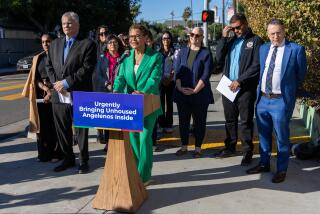Editorial: A new master plan could, and should, transform the VA’s West L.A. campus
The West L.A. campus of the U.S. Department of Veterans Affairs sprawls across 388 acres, variously marked by hillsides and flat lands, groves of eucalyptus, stately buildings and a bustling behemoth of a medical center. The land was deeded to the government as a place where disabled soldiers could live out their days. And though it will never be that again, a landmark court settlement announced this year set in motion an ambitious process to transform the campus from an isolated healthcare facility into a community where homeless veterans can live and all veterans can congregate, socialize and seek recreation and solace.
The recently released draft of a new master plan for the campus is the crucial first step. It lays out how that community can blend housing, recreation facilities, hospital and green space. But this is very much a work in progress, and the plan itself is open for public comments until early December. Hopefully, veterans in particular will comb through it and register their thoughts.
The most important element of the plan is the provision of 700 to 900 units of permanent supportive housing on the north side of the campus for the neediest and most fragile of homeless veterans — the chronically homeless, the physically disabled and women. According to the L.A. Homeless Services Authority’s official count in January, there were more than 4,000 homeless veterans living in Los Angeles County, the largest concentration of homeless veterans in the U.S.
Not all homeless veterans are chronically homeless — the chronic ones are those who have experienced long bouts of homelessness and who have a mental or physical disability or both — and not all chronically homeless veterans will want to live on the campus. Nor is this the only housing that the VA is working to provide for homeless veterans in the area. The figures arrived at in the plan take all that into account.
While those numbers may go up or down as the plan is revised and finalized, what should remain steadfast is the VA’s commitment to house homeless veterans and to create a community that offers therapeutic support as well as housing in pleasant surroundings. Many of the chronically homeless are aging and coping with physical ailments, and they need medical care on campus as much as they need therapeutic services to grapple with their psychological problems and, often, their addictions. No matter the hurdles ahead, including potential concerns from neighborhood groups, the VA should see this plan through and make sure that this desperately needed housing gets built.
Follow the Opinion section on Twitter @latimesopinion and Facebook
More to Read
A cure for the common opinion
Get thought-provoking perspectives with our weekly newsletter.
You may occasionally receive promotional content from the Los Angeles Times.






